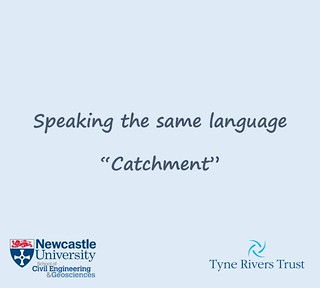Community Training & Resources
|
Training resources relevant to all river watchers: |
Training resource 1: Stay safe – a guide for river watchers
Please ensure you read this document before you carry out any monitoring activity
Training resource 2: Weather & floods, forecasts & warnings
Be prepared, know when to expect severe weather events and find out whether there are any weather or flood warnings in place affecting your local catchment.
- Met Office weather warning guide (for rain, hail. snow, wind and fog)
- Met Office weather forecast for Haltwhistle
- Met Office 24hr rainfall radar map
- Environment Agency flood warning guide
- Environment Agency River levels for South Tyne and Haltwhistle
- Live (interactive) gauge map of Environment Agency river levels by Shoothill
- NEW! Rain alarm app (for Apple devices) (for Android devices) (for desktops / web browsers)
- OpenStreetMap - maps for watercourses and footpaths
Training resource 3: understanding 'catchments'
- What do we mean by the term ‘catchment’? (click video below to view larger version):
- Natural Flood Management / working with natural processes - use video below as a training resource (an example taken from the Pont Gallon Burn leaky dams on 22nd Deceber 2014 - during a heavy winter storm):
|
Training resources to support community-based monitoring activities: |
Training resource 4: Rainfall
Manually observe daily rainfall using a plastic rain gauge in your garden:
Training resource 5: River level using a gauge board
Visually observe the river level gauge boards along the Haltwhistle Burn footpath:
Training resource 6: Flooding and extreme weather impacts
Observe changes in the water environment before, during and after a severe weather event (e.g. heavy rainfall which causes flooding)
Training resource 7: Water clarity
A simple technique which uses the OPALometer:
- Water clarity (OPALometer) training card
- Map of water clarity monitoring points
- Spare OPALometer disks
Training resource 8: Water quality
Simple techniques used to observe algal cover, temperature, pH, dissolved oxygen, nitrites/nitrates and phosphates – all of which are common water quality indicators for rural catchments:
- Water quality monitoring (overview) training card
- Water quality flash cards (individual tests)
- Map of water quality monitoring locations
Training resource 9: Fixed point photography for changing environments
Learn how you can use your camera at fixed locations over time to capture change within the water environment e.g. sediment build-up under culverts or erosion and river meander bends.
**Document coming soon**
Training resource 10: Aerial photography using drones, balloons or kites
Collect images of the river environment, flood extents or catchment management techniques (e.g. natural flood management features).
**Document coming in the future**
Training resource 11: Float gauging
Find out how fast the water is flowing using a float
**Document coming in the future**
Training resource 12: Weather diaries
Activities which tourists can complete and get involved with catchment management. See examples blow to get you started:
Training card 13: Invasive non-native species
Look out for invasive non-native plants and animals in your catchment. Training cards developed by the GB non-native species secretariat:
- Killer shrimp;
- Japanese knotweed;
- Giant hogweed;
- American mink;
- Signal crayfish;
- Rivers Trust raising awareness leaflet.
|
Training resources to help you submit your observations: |
Training resource 14: How to submit your observations – general overview
If you want to submit your observations using the internet (using a web form, file sharing site or by email) or to share during river watch meetings:
Training resource 15: Twitter
Use Twitter to submit your observations, interesting facts, local knowledge or photos of the Haltwhistle Burn catchment:
Training resource 16: Community river and weather app
An Android app which will allow you to submit your river levels, river observations and weather descriptions:
To download the app you need an Android device (version 4 onwards).
- Click here to download the app - get the app
If you (or anybody else in the community) use the app to submit your weather and river observations then they are automatically plotted on a map and shared online. This is called 'crowd-sourcing' which is essentially bringing knowledge or information together online from many different people.
- View your app observations on the Haltwhistle Burn community map here: http://ceg-sense.ncl.ac.uk/cloudsense/sinatra/trtmap.html.
| Disclaimer - project information and consent form: |
Please read and sign the the following information sheet which highlights your role as a volunteer and what your data will be used for:



